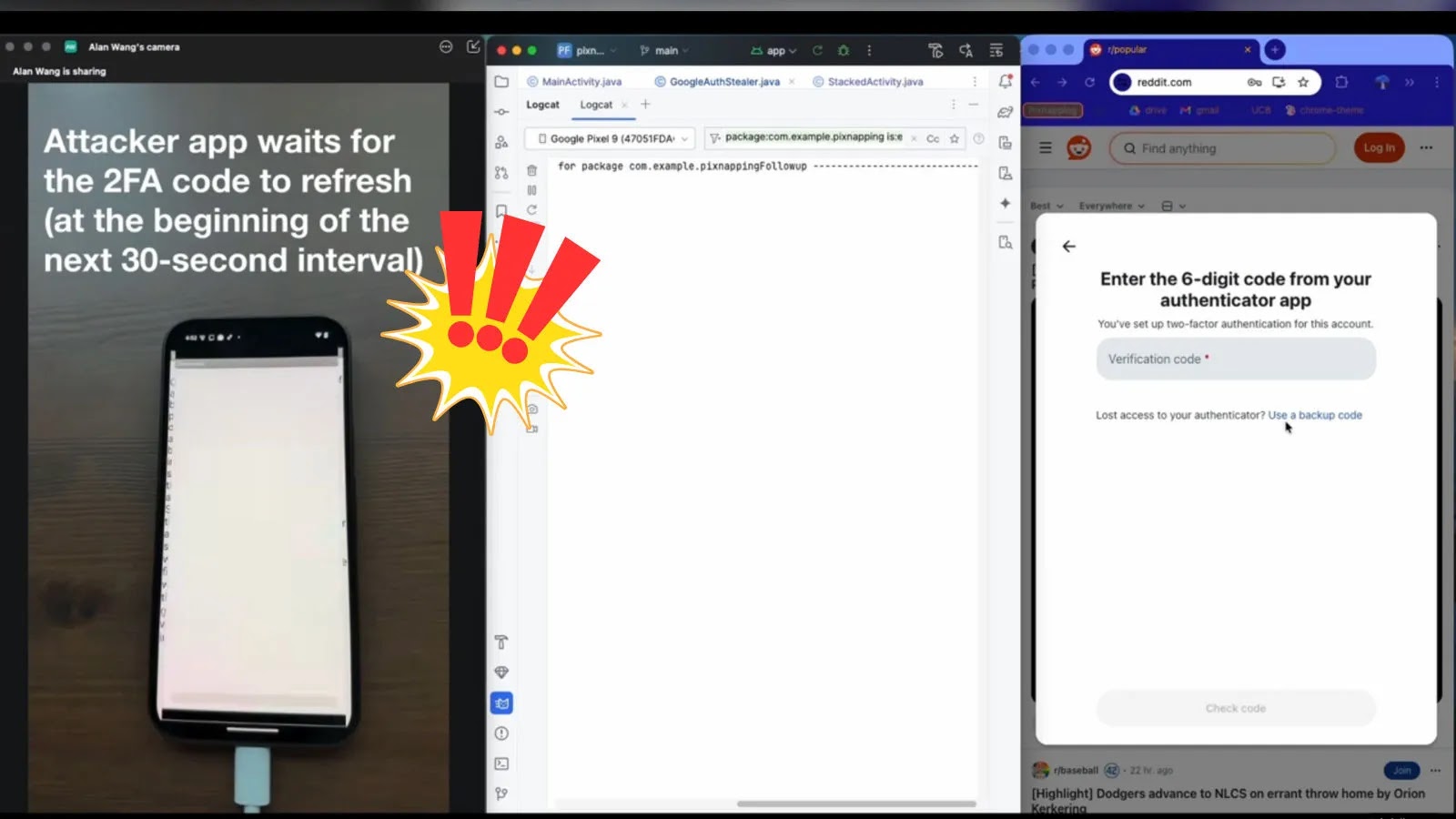
New Pixnapping Attack Steals 2FA Codes From Google Authenticator Within 30 Seconds
Unmasking Pixnapping: A Critical Threat to Your 2FA Security
In a landscape where multi-factor authentication (MFA) stands as a cornerstone of digital security, a newly identified vulnerability is sending ripples through the cybersecurity community. Researchers have unveiled “Pixnapping,” a sophisticated side-channel attack capable of silently extracting sensitive screen data, including critical two-factor authentication (2FA) codes from Google Authenticator, in less than 30 seconds. This exploit transcends traditional software vulnerabilities, leveraging an intricate combination of Android’s core APIs and a subtle hardware flaw inherent in Graphics Processing Units (GPUs) found in nearly all modern Android devices. The concerning aspect? It requires no elevated permissions, making it a particularly insidious threat to user data and account integrity.
What is Pixnapping and How Does It Work?
Pixnapping represents a novel class of attack targeting Android devices, specifically designed to covertly capture visual information displayed on a user’s screen. Unlike malware that injects itself into applications or steals data directly from memory, Pixnapping exploits the way GPUs render and process graphical data. The attack essentially “eavesdrops” on the device’s graphics pipeline. By manipulating Android’s standard APIs and understanding the nuances of GPU-accelerated rendering, attackers can reconstruct partial or full screen contents without triggering traditional security alerts or requiring special permissions.
The core mechanism revolves around a timing side-channel. Attackers measure precise time differences in how graphical elements are processed on the GPU. These minuscule timing variations, when cleverly analyzed, can reveal patterns that correspond to specific displayed content, such as the digits of a 2FA code. The attack is particularly effective against static or semi-static elements like the six-digit codes generated by Google Authenticator, as their consistent presentation makes them easier to infer from timing data.
The Hardware Vulnerability and Broad Impact
At the heart of the Pixnapping attack lies a hardware vulnerability within the Graphics Processing Units (GPUs) commonly integrated into almost all contemporary Android smartphones. While the exact CVE ID for this specific GPU vulnerability is not yet publicly disclosed as a standalone entry, the attack itself leverages known behaviors of these processors to achieve its objective. This widespread hardware commonality means that the attack surface is vast, encompassing a significant portion of the Android ecosystem. The lack of a specific CVE for the underlying hardware component highlights the challenge in patching such deep-seated architectural issues, often requiring firmware updates or even hardware revisions rather than simple software patches.
The exploit’s ability to operate without requiring special application permissions is another alarming facet. This means a seemingly innocuous application, perhaps disguised as a utility or game, could potentially execute a Pixnapping attack in the background without the user’s explicit consent for screen recording or sensitive data access. The speed of the attack, under 30 seconds, further reduces the window for detection and mitigation by the user.
Remediation Actions and Mitigations
Addressing the Pixnapping threat requires a multi-layered approach, involving both user vigilance and potential platform-level enhancements. Since the attack exploits core Android APIs and GPU behavior, a complete software patch from Google and device manufacturers is crucial.
- Application Updates: Keep your Google Authenticator and Android operating system updated to the latest versions. These updates often include security patches that could mitigate such side-channel attacks, even if the underlying hardware vulnerability persists.
- Consider Alternative 2FA Methods: While Google Authenticator remains widely used, consider hardware security keys (e.g., FIDO U2F/WebAuthn tokens) for critical accounts. These keys provide cryptographic proof of presence and are generally immune to screen-scraping attacks.
- Exercise Caution with App Permissions: Be extremely judicious about the permissions you grant to newly installed applications. While Pixnapping doesn’t require explicit “screen recording” permissions, limiting unnecessary access can still reduce the attack surface.
- Developer Guidance: Application developers, especially those handling sensitive information, should explore implementing visual countermeasures. For instance, frequently refreshing or subtly changing the visual display of sensitive data (e.g., OTP codes) can make side-channel attacks more difficult to execute reliably. Obfuscating UI elements or using hardware-backed keystores for sensitive data can further enhance security.
- Platform-Level Patches: Google and Android device manufacturers are expected to roll out updates that harden the graphics pipeline and potentially introduce stricter sandboxing or timing jitter to thwart such side-channel exploitations.
Tools for Developers and Security Professionals
While direct detection tools for Pixnapping are still emerging, developers and security analysts can utilize existing tools to analyze app behavior and potential side-channel leakage.
| Tool Name | Purpose | Link |
|---|---|---|
| Android Debug Bridge (ADB) | General device debugging, log analysis, and process monitoring. Can help identify suspicious app behavior or resource consumption. | https://developer.android.com/studio/command-line/adb |
| GPUWatch (via Android GPU Inspector) | Provides detailed GPU performance metrics, which could potentially reveal anomalous patterns during an attack. | https://developer.android.com/games/agvi |
| Frida | Dynamic instrumentation toolkit. Can be used to hook into Android APIs and monitor their usage in real-time, potentially detecting the API calls leveraged by Pixnapping. | https://frida.re/ |
| Malware Analysis Frameworks (e.g., Cuckoo Sandbox) | Automated malware analysis to observe application behavior in a controlled environment, revealing malicious activities. | https://cuckoosandbox.org/ |
Conclusion
The discovery of the Pixnapping attack underscores the persistent sophistication of adversaries and the need for continuous vigilance in cybersecurity. This novel side-channel exploit, leveraging both Android APIs and a GPU hardware vulnerability, highlights that even widely adopted security mechanisms like 2FA can be circumvented through clever engineering. While immediate panic is unwarranted, proactive measures such as maintaining updated software, considering hardware security keys, and exercising caution with application permissions are essential. The cybersecurity community, alongside Google and device manufacturers, must collaborate to implement robust mitigations and secure the digital experience against these evolving, subtle threats.





